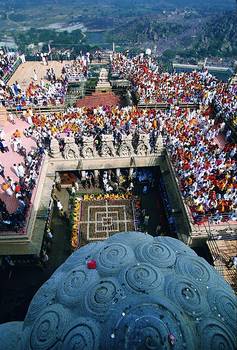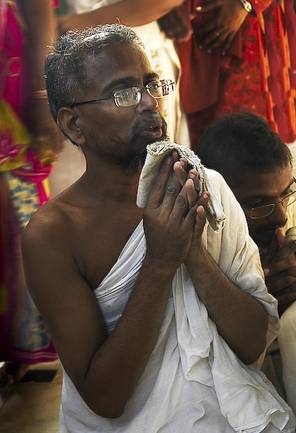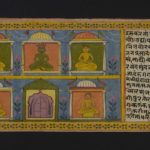Article: Pilgrimage
As in other Indian religious traditions, ‘pilgrimage’ in Jainism is known as tīrtha-yātrā – ‘going to a sacred place’. It is a Sanskrit term in common use even in modern Indian languages of north India. In earlier times, when travelling was done on foot, the word ‘pilgrimage’ was understood as meaning the complete journey. In today’s understanding, when most lay people use mechanical means of transportation, such as trains or cars, the yātrā is understood to imply only the part accomplished on foot. In many cases, when the main sacred centre is on top of a hill, climbing to the summit forms a key episode in the pilgrim’s progress.
Not all Jain sects perform pilgrimages. Only the sects that worship images and have temples undertake these spiritual journeys. A place normally becomes a destination for pilgrims because of its connection with a Jina. Sites associated with prominent religious teachers may also become pilgrimage attractions. Jain mendicants are permanent pilgrims and visits to holy places are part of their daily life. They may also keep specific vows on their journey to a certain site. Ascetics also encourage the laity to organise travel to distant places. In both the past and present, monks and nuns are often the driving forces behind the creation of new holy places and, consequently, new pilgrimages.
Pilgrimage may be mental or physical for Jains. Artworks in temples and homes provide the focus of concentration for mental journeys, which are quite common and gain a lot of karmic merit. Jains chiefly undertake pilgrimages for the spiritual benefits they bring. This is partly related to the normal lifestyle of ascetics that lay Jains adopt before and during pilgrimage. The physical discomforts of mendicant lifestyle are accompanied by meditation and a focus on religious teachings instead of everyday life. Going on pilgrimage is also an important method of strengthening faith and binding Jains together, as they share hardships along the way and the joy of reaching their destination.
Usually undertaken outside the rainy season, pilgrimages are commonly timed to finish on a holy day. Sites associated with certain Jinas, events or individuals often see great crowds of pilgrims on commemorative festivals.
Despite the longstanding significance of pilgrimage for Jains, it is difficult to determine when it became an institution. From the 14th century onwards, it becomes a prescribed religious activity in the handbooks of rules governing the lives of lay people – śrāvakācāra. There are numerous descriptions or reports from this period showing that pilgrimages were an important part of religious life, although they were not compulsory.
Pilgrimage destinations
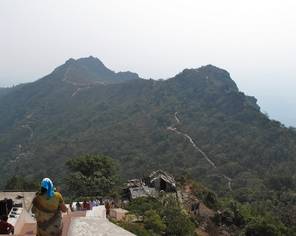
Pilgrims at Mount Sammeta
Image by Deeeep – Deepak Mehta © CC BY-NC 2.0
Defined by the presence of temples and images – mūrti – Jain holy places are the focus of pilgrimage mainly for Jains who believe in image-worship. Well-known examples include Mount Shatrunjaya and Shravana Belgola.
Holy sites are usually sanctified by events connected with a Jina or a leading religious figure. The 14th-century Śvetāmbara author Ratnaśekhara-sūri defines a pilgrimage – tīrtha-yātrā – ‘as meaning the visiting of such places as Shatrunjaya and Raivata [= Girnar] where the atmosphere is hallowed by association with the birth, initiation, enlightenment, or nirvāṇa of tīrthaṅkaras‘ (Williams 1963: 235).
Jains of all sects are often willing to undertake a pilgrimage to the place where a Jain mendicant they think of as their special guru stays for a time. A mendicant is regarded as a ‘moving tīrtha’ – jangama-tīrtha.
Mental pilgrimage
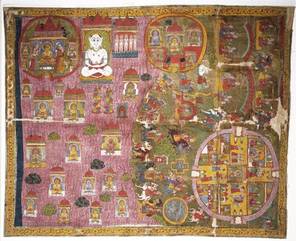
Paṭa of Mount Shatrunjaya
Image by Brooklyn Museum Collection © no known copyright
The concept of completing a mental pilgrimage is codified in Jainism and known as bhāva-yātrā. The pilgrims do not journey to the holy place physically. Instead, they are transported there mentally when they view cloth hangings – paṭas – on which the prominent tīrthas of sacred places such as Shatrunjaya, Girnar, Sammet Shikhar and others are depicted.
These pictures are displayed permanently in temples or brought out occasionally on special days for the benefit of all. Many Jains keep photographs, magnets or traditional paintings of these places in their homes as well.
This form of pilgrimage is a substitute for bodily pilgrimage, especially for people who cannot travel because of illness or physical condition. This kind of journey is also made during the rainy season, when pilgrimages are generally not undertaken. A mental pilgrimage is not necessarily considered less meritorious than the physical journey. On the contrary, Jain ascetics tend to consider it the highest form of pilgrimage.
Why go on a pilgrimage
There are a few main reasons Jain followers perform a pilgrimage.
Jain teachers and devotees alike give spiritual progress as the first reason. Karmic effects, positive or negative, are regarded as being more powerful in sacred places. In these places not only are sins removed more easily but merits are acquired more easily as well.
One important pilgrimage motivation is to have or take the darśana of the Jina image, meaning to see and worship it. The Jinas, who are at the centre of Jain sacred sites, are not worshipped to gain worldly benefits. Thus, in principle, Jains do not expect a miracle or improvement in their own lives after completing a pilgrimage to a Jain sacred place.
Sometimes Jains go on pilgrimage for other reasons. For example, Jains who want children often turn to family deities, who can intervene in affairs of the world because they are not liberated beings, yet have magical powers. They may undertake pilgrimages to their ancestral villages to visit deities associated with their family history.
In addition, curative powers are often attached to natural features in sacred places, such as trees and ponds. For instance, while visiting pilgrimage destinations, Jains may include stops at these natural features in the hope of curing infertility.
As a mostly group activity, a pilgrimage is also a period when the lay community’s cohesion is strengthened and faith refreshed. It is not compulsory but it is among favoured lay activities because it combines religious and recreational aspects.
When to go on a pilgrimage
Pilgrimages are forbidden, or at least not encouraged, during the rainy season, for practical as well as religious reasons. Some holy sites are closed during this season. In other cases, site management organisations do not provide any of the normal facilities during this period. There are, however, disagreements on this point concerning pilgrimage to Shatrunjaya (Luithle-Hardenberg, The Pilgrimage, 2010: 337).
Some of the major Jain festivals are occasions for large-scale pilgrimages when they are either connected or often linked with a specific sacred place. Examples include the:
- Great head-anointing of Bāhubali in Shravana Belgola
- Akṣaya-tṛtīyā with Mount Shatrunjaya
- Hastināpura and Dīvālī with Pāvāpurī.
More generally, on special occasions believers commonly undertake pilgrimages to a place that houses an image said to have special powers, instead of going to the local temple.
Organising a pilgrimage
Nowadays the popular pilgrimage sites offer facilities to the thousands of religious visitors who journey there each year. Even so, arranging a pilgrimage is an important matter in religious life and a leading member of a lay community often does this. Bringing the official title of saṅgha-pati – ‘lord of the community’ – this prestigious position indicates considerable wealth and is a chance to earn religious merit.
In the past, a group of pilgrims would have had to cross dangerous places. It was customary for them to inform the local political authorities of their travel plans. In the Mughal period, they would issue formal edicts – farmāns – equal to official authorisation. This was a way the pilgrims could ensure some safety.
Rich and pious lay men, including kings or government ministers, often organised pilgrimages that involved huge crowds, along with servants and animals carrying food and water. Cloth paintings of sacred places – paṭas – often depict these pilgrimage processions in great detail. Departure was fixed for an auspicious day, with the planets in favourable positions. Stories of rich patrons organising pilgrimages, of journeys where hardships alternated with the satisfaction of witnessing miracles in shrines, are plentiful. A record of a 1935 pilgrimage from Ahmedabad to Shatrunjaya (Cort 1990: 290) provides the impressive numbers of:
- 400 monks
- 700 nuns
- 15,000 laity
- 1,300 bullock carts
- 200 big tents
- 900 small tents
- 200 servants and cooks
- 200 watchmen
- 100 volunteers
- a cost between 500,000 and 600,000 rupees.
Small pilgrimages last one day, but larger ones can last several days or weeks. In the past, organising a pilgrimage meant finding places to rest or stay overnight, where new pilgrims would join the group. Community networks were used so that along the way pilgrims could stay either with fellow Jains or in large halls or buildings known as sarāīs. Feasts were also organised on the journey.
Today, many of the prominent sacred places such as Shatrunjaya and Shravana Belgola provide modern accommodation and eating facilities for pilgrims. Here, pilgrims usually stay in rest-houses – dharma-śālās – which are organised partly by the managing trusts and by caste or regional organisations. Placed outside the holy site itself, dharma-śālās vary from the very simple, where pilgrims sleep in small cells, to the very luxurious, where the rooms have en-suite bathrooms. In places such as Palitana, these pilgrim hostels can be viewed as manifestations of local communities, and they reflect ‘the divisions of the Śvetāmbara Jains according to local origin and to ascetic branches and sub-branches’ (Luithle-Hardenberg, The Pilgrimage, 2010: 332). Pilgrims eat in refectories – bhojana-śālās – where they find purely vegetarian food conforming to the rules of Jain diet. The walls of the eating-hall are often adorned with portraits of the wealthy lay people who have donated money towards its establishment.
Elements of a pilgrimage
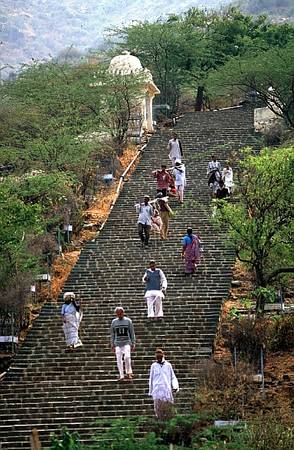
Steps to Shatrunjaya temples
Image by unknown © unknown
Before beginning their journey, pilgrims prepare by starting to live the mendicant lifestyle. Going on pilgrimage is the closest that most lay Jains come to the wandering life of monks and nuns, which is physically and mentally demanding. Mendicants are frequently found at pilgrimage destinations and may lead groups of pilgrims if they all travel on foot. Many Jain sacred places are located on top of hills where pilgrims are not allowed to stay overnight. Thus they usually complete the final stage of their journey in one day. The pilgrims climb up the sacred hill and tour the temples that make up the pilgrimage site. It is often a profoundly spiritual and emotional experience, increased by performing rites of worship in the holy place. Devotees also usually donate money to the management of the site, for upkeep of the temples and so on.
Jains who are planning to go on pilgrimage carry out mental preparation and special observances. These involve dietary restrictions, sleeping on the ground, meditating, abstaining from sexual relations and keeping to religious restraints. During the pilgrimage the followers aim to come as close as possible to mendicant life. They do not think any longer about the concerns of worldly life, for pilgrimage is a time to focus on religious discourse or teachings.
This is formalised in the so-called cha rī pālit among Śvetāmbaras from Gujarat, which emphasises six restrictions that people do not necessarily follow the rest of the time. The would-be pilgrims must:
- follow the strict dietary rules that only ascetics usually observe
- eat only once a day and not eat anything after sunset
- walk barefoot and not use any means of transportation
- sleep on the floor
- remain celibate
- perform the ritual of forgiveness by reasserting that all living beings are dear to them.
First, pilgrims arrive in the neighbouring village or town, where they stay and eat. Then they travel on foot up the hill, to reach the main temples. In some places, like Shravana Belgola, pilgrims have to walk barefoot, but even when this not a rule many people choose to do so. In places like Shatrunjaya, elderly or ill pilgrims can be carried up the steep hill in a ḍolī. This is a kind of individual seat on which the passenger sits cross-legged, which hangs from ropes attached to a bamboo pole carried between two men.
The ‘99fold’ – navanu – pilgrimage to Shatrunjaya (Luithle-Hardenberg 2010) is characterised by extreme asceticism and is an endurance challenge. Along with observing numerous restrictions, pilgrims who perform this have to complete the journey to the main temple on the top of the hill 108 times over two months.
Pilgrims frequently recite in a low voice or sing hymns along the way or when reaching the temples that are their destination. They often express their joy by spontaneously composing devotional poems.
A pilgrimage is complete when the devotee has visited all the sacred spots in a holy place and has had the ‘sight’ – darśana – of all the images there. In large pilgrimage centres like Mount Shatrunjaya there are several possible routes that allow the pilgrim to pass near each and every spot. A ‘temple circuit’ – caitya-paripāṭī – is a necessary part of pilgrimage. Modern guidebooks or publications of hymns provide lists of the temples to be covered, along with information about their location, the name of the main JinaJina image and so on.
Worship – pūjā – is performed in the same way it is in daily practice. However, special pūjā rites can also be organised for large group pilgrimages.
Mendicants are often seen at pilgrimage sites. For Mūrti-pūjak Jains, pilgrimage is a common activity. To some extent, the whole life of wandering – vihāra – of monks and nuns is a permanent pilgrimage, since holy places are where they often stop. They may also lead groups of laity on their pilgrimages in the rare cases where the whole journey is done on foot.
Pilgrims also make donations to the temple management.
A pilgrim’s experience

Banārasīdās throws away his poem
Image by unknown © unknown
All Jain pilgrims experience the key moment that a pilgrimage represents in an individual’s life and spiritual development.
In the middle of the 17th century the Jain merchant Banārasīdāsas, who became a leading figure in the Adhamātya movement, reported his own experience in his memoirs. The party of pilgrims visits different holy sites during this single pilgrimage. Banārasīdāsas’s response is representative of the general experience Jain pilgrims seem to have.
Vardhaman Kunwarji, a broker, had collected a company to go on pilgrimage; Banarasi joined the company of pilgrims. The pilgrimage was to Ahichhatrapur and Hastinapur. Banarasi left one early morning, taking his mother and wife with him. They sat in the carriage, all three, in a state of unbroken devotion for the entire journey. In Samvat 1675, at an auspicious hour in the month of Paush, they offered puja at Ahichhatrapur. Then they moved to Hastinapur, where they paid homage to the tirthankar[s] Shantinath, Kunthunath and Aranath. In honour of Shanti, Kunthu and Aranath, Banarasi composed a verse which he would recite every day with great devotion. […] After the pilgrimage, Banarasi’s heart filled with gladness. The company of pilgrims then turned towards Delhi.
Half a Story
translation by Chowdhuri, page 243, stanzas 579 ff.
This account describes simply the various stages of the spiritual and physical journey that form a pilgrimage.
Reading
- Ardhakathanak: A Half Story
Banārasīdās - translated by Rohini Chowdhury
Penguin Books India; New Delhi, India; 2009
- Organizing Jainism in India and England
Marcus Banks - Oxford Studies in Social and Cultural Anthropology series; volume 3
Clarendon Press; Oxford, UK; 1992
- Jains in the World: Religious Values and Ideology in India
John E. Cort - Oxford University Press USA; New York, USA; 2001
- The Jains
Paul Dundas - Library of Religious Beliefs and Practices series; series editor John Hinnels and Ninian Smart; volume 14
Routledge Curzon Press; London, UK; 2002
- ‘The Pilgrimage to Shatrunjaya: Refining Shvetambara Identity’
Andrea Luithle-Hardenberg - An Anthropology of Values – essays in honour of Georg Pfeffer
edited by Peter Berger, Roland Hardenberg, Ellen Kattner and Michael Prager
Pearson Longman; Delhi, India; 2010
- ‘The “99fold“ pilgrimage to Shatrunjaya: A case study of young women’s embodiment of Jaina tradition’
Andrea Luithle-Hardenberg - Svasti – essays in honour of Prof. Hampa Nagarajaiah
edited by Nalini Balbir
Muddushree Granthamala series; volume 75
K. S. Muddappa Smaraka Trust; Bangalore, Karnataka, India; 2010
- Śrāddhavidhiprakaraṇa
Ratnaśekhara-sūri - Śreṣṭhi-Devacanda-Lālbhāī-Jaina Pustakoddhara Fund series; volume 106
Surat, Gujarat, India; 1960
- Historical Dictionary of Jainism
Kristi L. Wiley - Historical Dictionaries of Religions, Philosophies, and Movements series; series editor Jon Woronoff; volume 53
Scarecrow Press; Maryland, USA; 2004
- Jaina Yoga: A Survey of the Mediaeval Śrāvakācāras
Robert Williams - London Oriental series; volume XIV
Oxford University Press; London, UK; 1963
Links
- Paṭa of Mount Shatrunjaya
-
A 19th-century Rajasthani example of a paṭa – decorative map of a holy site – of the pilgrimage centre of Mount Shatrunjaya. Owned by the Philadelphia Museum of Art in the United States, the paṭa can be enlarged by clicking on the icon of the magnifying glass. A paṭa can be used to complete a mental pilgrimage to the place depicted, which is believed to be of even more religious value than making the physical journey.
http://www.philamuseum.org/collections/permanent/68189.html?mulR=31553|11
- Types of Jain holy sites
-
Shugan Chand Jain classifies Jain holy sites in this excerpt from his piece entitled 'Jain Festivals (Parva) and Jain Pilgrimage (Teerth yatra)-(B) Pilgrimage'. It forms part of the study notes offered by the International School for Jain Studies in 2009.
This extract was published on HereNow4U.net in 2008.
- Views of pilgrimage site of Gwalior
-
Photographs of Gwalior in Madhya Pradesh, including details of interior architecture and the numerous large statues of Jinas for which the site is famous.
Provided by the World Art Treasures, the Fondation Jacques-Edouard Berger in Lausanne, Switzerland.
(Input Gwalior in Madhya Pradesh in Search)
- Jina images and temples at Gwalior
-
The pilgrimage centre of Gwalior in central India is famous for its carvings of Jinas. Both freestanding and relief sculptures, the Jinas are found in the temples as well as in panels cut into walls of rock. This collection of drawings and photographs is presented by Professor Frances W. Pritchett of Columbia University in New York.
http://www.columbia.edu/itc/mealac/pritchett/00routesdata/1000_1099/jaintemples/gwalior/gwalior.html
- Views of the temple at Ranakpur
-
One of the foremost Śvetāmbara pilgrimage sites, the main temple at Ranakpur has around 1,400 intricately carved marble columns. This collection of photographs of the Ādinātha temple at Ranakpur in Rajasthan is presented by Professor Frances W. Pritchett of Columbia University in New York.
- List of Digambara holy places
-
Jainteerth.com provides a list of Digambara holy places in India, complete with details of the main temple and idol, location, travel information, facilities for pilgrims and contact details of the management organisation. The site also offers background information on temples and Jain principles. Unfortunately, the standard of English is not very good.
- Early photographs of Mount Abu
-
Historical photographs of Mount Abu, popular pilgrimage site famous for its white marble temples, presented by Professor Frances W. Pritchett of Columbia University in New York.
- Jain temples
-
A comprehensively illustrated examination of Jain temples from an architectural viewpoint. Entitled 'Jaina Architecture in India', the material has been collected by a Japanese architect, Takeo Kamiya, over 30 years. It covers major pilgrimage destinations as well as smaller shrines throughout India.
- A Śvetāmbara nun descends from Shatrunjaya
-
A nun from a Śvetāmbara Mūrtipūjaka mendicant order runs barefoot down the steps leading down from Mount Shatrunjaya. This temple-city in Gujarat is one of the most significant Śvetāmbara Mūrtipūjaka pilgrimage sites. The steep path from the foot to the summit, where the principal shrines are found, has around 4000 steps.
- +
- aAbhavya
- aAbhinandana
- aAbhiṣeka
- aĀcāra
- aĀcārāṅga-sūtra
- aĀcārya
- aAchalbhrata
- aAḍhāī-dvīpa
- aAdharma
- aAdho-loka
- aAdhyayana
- aAdvaita Vedānta
- aĀgama
- aAghātīya
- aAghātīya-karman
- aAgnibhuti
- aAgra
- aĀhāra
- aAhiṃsā
- aAhimsa Day
- aAjita
- aAjīva
- aAkampit
- aĀkāśa
- aAkbar the Great
- aAkṣaya-tṛtīyā
- aAlauddin Khalji
- aAlbert Einstein
- aAllah
- aAlms
- aĀlocanā
- aAloka-ākāśa
- aAmāri
- aAmbikā or Kūṣmāṇḍinī
- aAnagāra
- aAnanta
- aAnarthadaṇḍa
- aAnaśana
- aAnekānta-vāda
- aAṅga
- aAniconism
- aAnojjā
- aAntarāla
- aAntarāya-karma
- aAṇu
- aAṇu-vrata
- aAnukampā
- aAnuprekṣā
- aAnusvāra
- aApabhraṃśa
- aAparigraha
- aAra
- aĀrambha
- aĀrambhaja
- aĀratī
- aArdhamāgadhī Prākrit
- aArhaṃ
- aArhat
- aArśana-āvaraṇīya-karma
- aĀrta-dhyāna
- aĀryikā
- aĀryikā Jñānamati
- aĀśātanā
- aĀścarya
- aAscetic
- aAsceticism
- aAshram
- aAspiration
- aĀsrava
- aAṣṭa-maṅgala
- aAṣṭāpada
- aAstikāya
- aAstrolabe
- aAsura
- aAtheism
- aAticāra
- aAtiśayakṣetra
- aAtithisaṃvibhāgavrata
- aĀtma-vāda
- aĀtman
- aAuṃ
- aAurangzeb
- aAuspicious
- aAusterity
- aAvadhāna
- aAvadhi-jñāna
- aĀvaraṇī-yakarman
- aAvasarpiṇī
- aAvatāra
- aAvidyā
- aAxiom
- aĀyāga-paṭa
- aĀyambil
- aĀyu-karma
- aĀyurveda
- bBabur
- bBāhubali
- bBaladeva
- bBālāvabodha
- bBandha
- bBasadi
- bBazaar
- bBhadrankarvijay
- bBhagavant
- bBhaktāmara-stotra
- bBhakti
- bBhale
- bBharata
- bBhāṣā
- bBhāṣya
- bBhaṭṭāraka
- bBhāva
- bBhāva-pūjā
- bBhāvanā
- bBhavana-vāsin
- bBhavya
- bBhavyatva
- bBhaya
- bBhoga-bhūmi
- bBhogopabhoga
- bBodhi
- bBollywood
- bBrahmā
- bBrahma-deva
- bBrahmacārī
- bBrāhmaṇa
- bBraj Bhāṣā
- bBright fortnight
- bBritish Raj
- bBuddha
- bBuddhi-sagar
- bBuddhism
- bBuddhist
- cCaitya
- cCaityavāsin
- cCakravartin
- cCakreśvarī
- cCāmara
- cCandanā
- cCandragupta
- cCandraprabha
- cCanon
- cCāritra
- cCāritramohanīya-karman
- cCarũrī
- cCaste
- cCaturvidha-saṅgha
- cCaturviṃśati-stava
- cCāturyāma
- cCE
- cCelibacy
- cCha
- cChadmastha
- cChastity
- cCheda-sūtra
- cChristian
- cChristianity
- cClergy
- cCloning
- cColophon
- cCommentary
- cConch
- cConfession
- cCongregation
- cConsecration
- cCosmology
- cCremation
- cCrore
- cCult
- cCūrṇi
- dDādā-guru
- dDalit
- dDāna
- dDaṇḍa
- dDark fortnight
- dDarśana
- dDarśanamohanī-yakarman
- dDaśa-lakṣaṇa-parvan
- dDeity
- dDelhi Sultanate
- dDerāsar
- dDeśāvakāśika-vrata
- dDetachment
- dDevanāgarī
- dDevānandā
- dDevarddhi-gani
- dDevotee
- dDhamal
- dDhanuṣ
- dDhāra
- dDharma
- dDharma-dhyāna
- dDharma-sāgara
- dDharmastikaya
- dDhātakīkhaṇḍa
- dDholak
- dDhyāna
- dDiaspora
- dDig-vrata
- dDigambara
- dDīkṣā
- dDisciple
- dDīvālī
- dDivya-dhvani
- dDNA
- dDoctrine
- dDogma
- dDonor
- dDoṣa
- dDravya
- dDravya-pūjā
- dDrone
- dDuṣamā
- dDuṣamā-duṣamā
- dDuṣamā-suṣamā
- dDveṣa
- dDvīpa
- eEast India Company
- eEightfold Path
- eEkānta-vāda
- eEkendriya
- eElder
- eElders
- eEschatology
- eEtc up to
- fFarmān
- fFast
- fFatehpur Sikri
- fFestival
- fFestschrift
- fFiruz Shah
- fFly-Whisks
- fFolio
- fFour Noble Truths
- gGaccha
- gGaṇa
- gGaṇadhara
- gGanadharavada
- gGaṇeśa
- gGaṇin
- gGarba
- gGarbha
- gGarbha-gṛha
- gGaruḍa
- gGati
- gGene
- gGenomics
- gGhātī-yakarman
- gGhātīya
- gGhaznavid
- gGhiyasuddin Tughlaq
- gGhurid
- gGloss
- gGotra-karma
- gGujarāt
- gGujarati
- gGuṇa
- gGuṇa-sthāna
- gGuṇa-vrata
- gGupti
- gGuru
- gGuruṇī
- hHagiography
- hHajj
- hHaṃsa
- hHaribhadra
- hHariṇaigameṣin
- hHasta
- hHeresy
- hHiṃsā
- hHindi
- hHindu
- hHinduism
- hHīravijaya
- hHoroscope
- hHrīṃ
- hHumayun
- hHymn
- iIconoclasm
- iIconography
- iIdol
- iIndian Independence
- iIndology
- iIndra
- iIndrabhūti Gautama
- iIndriya
- iInitiation
- iIntercession
- iInvocation
- iIQ
- iIslam
- iIslamicate
- iIṣṭadevatā
- iĪśvara
- jJagat
- jJahangir
- jJain
- jJaina Devanāgarī
- jJaina Śaurasenī
- jJaina-dharma
- jJainaśāsana
- jJainness
- jJaisalmer
- jJamāli
- jJambū-dvīpa
- jJames Burgess
- jJanma
- jJanma-kalyāṇa
- jJarā
- jJāti
- jJina
- jJina-āgama
- jJina-bhavana
- jJina-bimba
- jJina-mātā
- jJinacandra-sūri
- jJinadatta
- jJinaprabha
- jJīva
- jJñāna
- jJñāna-āvaraṇīya-karma
- jJñāna-āvarṇiya
- jJñānsundar
- jJyotiṣka
- kKāla
- kKālakācārya-kathā
- kKālidāsa
- kKalpa-sūtra
- kKalpa-vṛkṣa
- kKalyāṇaka
- kKalyanvijay
- kKamaṇḍalu
- kKamaṭha
- kKarma
- kKarma-bhūmi
- kKarma-grantha
- kKarma-prakṛti
- kKarma-vāda
- kKarmon
- kKarnataka
- kKaṣāya
- kKathā
- kKāvya
- kKāya
- kKāyotsarga
- kKeśa-loca
- kKetu
- kKevala-jñāna
- kKevalin
- kKhalji
- kKharatara-gaccha
- kKnowledge
- kKriyā
- kKriyā-vāda
- kKṛṣṇa
- kKṣamā-śramaṇa
- kKṣapakaśreṇi
- kKṣatriya
- kKṣullaka
- kKulakara
- kKundakunda
- kKunthu
- lLabdhi
- lLaity
- lLakh
- lLāñchana
- lLands of Action
- lLaukāntika
- lLavaṇa-samudra
- lLeśyā
- lLiṅga
- lLinguistics
- lLoka
- lLoka-ākāśa
- lLoka-puruṣa
- lLoka-vāda
- lLotus
- lLotus lake
- mMadhya-loka
- mMahā-videha
- mMahā-vrata
- mMahābhārata
- mMahāmastakābhiṣeka
- mMāhārāṣṭra
- mMāhārāṣṭrī Prākrit
- mMahattarā Yākinī
- mMahāvīr Jayantī
- mMahāvīra
- mMakāra
- mMakkhali Gośāla
- mMalli
- mMāna-stambha
- mManaḥ-paryāya-jñāna
- mMaṇḍala
- mMaṇḍapa
- mMandit
- mMaṅgala
- mMantra
- mMantras
- mManuṣya-loka
- mMarāṭhī
- mMārgaṇā
- mMartyr
- mMarudevī
- mMaṭha
- mMati-jñāna
- mMauryaputra
- mMecca
- mMendicant lineage
- mMetarya
- mMiracle
- mMithyādṛṣṭi
- mMohandas Gandhi
- mMohanīya-karma
- mMokṣa
- mMonastic order
- mMonasticism
- mMonk
- mMonotheism
- mMosque
- mMount Meru
- mMount Sammeta
- mMṛgāvatī
- mMughal
- mMuhammad
- mMuhammad bin Tughlaq
- mMuhpattī
- mMūla-sūtra
- mMūlaguṇa
- mMumbaī
- mMuni
- mMunisuvrata
- mMurad Bakhsh
- mMūrti-pūjaka
- mMuslim
- mMysticism
- nNābhi
- nNāga-kal
- nNāgapurīya Tapā-gaccha
- nNāgarī
- nNāma-karma
- nNamaskāra-mantra
- nNami
- nNandīśvara-dvīpa
- nNandivardhana
- nNandyāvarta
- nNāraka
- nNāraki
- nNasalisation
- nNātha
- nNavrātrī
- nNaya-vāda
- nNemi
- nNidāna
- nniggaṃthāṇa vā 2
- nniggaṃtho vā 2
- nNigoda
- nNihnava
- nNikṣepa
- nNirgrantha
- nNirjarā
- nNirvāṇa
- nNiryukti
- nNiṣidhi
- nNitya
- nNiyati
- nNo-kaṣāya
- nNudity
- nNun
- oOcean of milk
- oOmniscience
- oOrdination
- ppa°
- pPadmaprabha
- pPadmāsana
- pPadmāvatī
- pPādukā
- pPalanquin
- pPalette
- pPañca-muṣṭi
- pPāṇḍava
- pPaṇḍit
- pPandit Dalsukh D. Malvania
- pPandit Sukhlalji
- pPāṇipātra
- pPāpa
- pParamātman
- pParameṣṭhin
- pPāraṇā
- pParigraha
- pPariṇāma
- pParīṣaha
- pParokṣa
- pPārśva
- pPārśvanātha
- pParyāya
- pParyuṣaṇ
- pPaṭa
- pPatan
- pPātra
- pPenance
- pPersian
- pPhala
- pPhilology
- pPicchikā
- pPilgrimage
- pPīr
- pPolymath
- pPoṣadha
- pPossession
- pPothī
- pPrabhas
- pPradakṣiṇā
- pPradeśa
- pPrākāra
- pPrakīrṇaka-sūtra
- pPrākrit
- pPramāda
- pPramukhā
- pPrati-vāsudeva
- pPratikramaṇa
- pPratimā
- pPratiṣṭhā
- pPratyākhyāna
- pPratyakṣa
- pPravacana
- pPrāyaścitta
- pPrayer
- pPre-modern
- pPreach
- pPredestination
- pProtestant
- pProvenance
- pPudgala
- pPūjā
- pPujārī
- pPukharavara-dvīpa
- pPuṇya
- pPūrva
- pPuṣkara-dvīpa
- pPuṣpadanta
- pPyre
- qQur’an
- rRāga
- rRāhu
- rRainy season
- rRajasthan
- rRajasthani
- rRājimatī
- rRajoharaṇa
- rRajput
- rRāma
- rRāmāyaṇa
- rRangoli
- rRās-garbā
- rRasa
- rRathanemi
- rRatna-traya
- rRātri-bhojana
- rRaudra-dhyāna
- rRecto
- rRelic
- rRenunciation
- rRetroflex
- rRevatī
- %Ṛg-veda
- rRite
- rRosary
- %Ṛṣabha
- %Ṛṣabhanātha
- rRupee
- sSaciyā Mātā
- sSādhu
- sSādhvī
- sSāgāra
- sSaint
- sŚaivaism
- sŚaka-saṃvat
- sSallekhanā
- sŚalya
- sSamacatuṣṭha
- sSamādhimaraṇa
- sSamaṇi
- sSāmarambha
- sSamavasaraṇa
- sSāmāyika
- sSaṃbhava
- sSamiti
- sSaṃjñā
- sSaṃkalpaja
- sSaṃsāra
- sSamudghāta
- sSaṃvara
- sSaṃvega
- sSamyak-cāritra
- sSamyak-darśana
- sSamyak-jñāna
- sSamyaktva
- sSaṃyama
- sSanctuary
- sSandalwood
- sSaṇgha
- sSanskrit
- sSant
- sŚānti
- sSapta-bhaṅgi-naya
- sSārambha
- sSarasvatī
- sSarvajña
- sSāsan-devi
- sŚāsana-devatā
- sŚāstra
- %Ṣaṭ-jīvanikāya
- sSatī
- sSatīmātā
- sSatya
- sSchism
- sScribe
- sScripture
- sSect
- sSecularism
- sŚenāī
- sSermon
- sŚeṣavatī
- sSevā
- sSeven fields of donation
- sShah Jahan
- sShantidas Jhaveri
- sShrine
- sSiddha
- sSiddha-śilā
- sSiddhacakra or Navadevatā
- sSiddhānta
- sSiddhārtha
- sSiddhi
- sSikh
- sSikhism
- sŚikṣā-vrata
- sŚīla
- sSin
- sSindh
- sŚītala
- sŚiva
- sSkandha
- sSomanatha
- sŚraddhā
- sŚramaṇa
- sŚrāvaka
- sŚrāvakācāra
- sŚrāvikā
- sŚreyāṃsa
- sŚrī
- sŚrīvatsa
- sŚruta-jñāna
- sŚruta-pañcamī
- sSthānaka-vāsin
- sSthāpanācārya
- sSthāvara
- sSthavira
- sSthiti
- sStrīmukti
- sStūpa
- sSubcontinent
- sSudarshana
- sŚuddhi
- sSudharma
- sŚūdra
- sSufism
- sSukha
- sŚukla-dhyāna
- sSulasā
- sSultan
- sSumati
- sSundarśrī
- sSupārśva
- sSūri
- sSuṣamā
- sSuṣamā-duṣamā
- sSuṣamā-suṣamā
- sSūtra
- sSuyam me ausam! Tenam bhagavaya evamakkhayam
- sSvādhyāya
- sSvāhā
- sSvastika
- sŚvetāmbara
- sŚvetāmbara Terāpanthin
- sŚvetāmbaras
- sSwan
- sSyād-vāda
- tTabla
- tTantra
- tTapā-gaccha
- tTapas
- tTāraṇ Svāmī Panth
- tTattva
- tTattvārtha-sūtra
- tTemple
- tTemple-city
- tThe Enlightenment
- tTheology
- tThree worlds
- %Ṭīkā
- tTilaka
- tTīrtha
- tTīrthaṃkaranāma-karman
- tTīrthankara
- tTransliteration
- tTrasa
- tTrasa-nāḍī
- tTriśalā
- tTriṣaṣṭi-śalākā-puruṣa-caritra
- tTti bemi
- tTughlaq
- tTunk
- uUdumbara
- uUniversal History
- uUpādhyāya
- uUpāṅga
- uUpaniṣads
- uUpāsaka
- uUpasarga
- uUpāśraya
- uŪrdhva-loka
- uUtsarpiṇī
- uUttarādhyayana-sūtra
- vVāhana
- vVaimānika
- vVairāgya
- vVaiṣṇava
- vVaiśramaṇa
- vVaiśya
- vValabhī
- vVanaspatikāya
- vVandana
- vVaṇik
- vVarṇa
- vVāsudeva
- vVāsupūjya
- vVayubhūti
- vVeda
- vVedanīya-karma
- vVegetarianism
- vVehicle
- vVernacular
- vVerso
- vVidyā
- vVidyā-devī
- vVihāra
- vVijñapti-patra
- vVikrama-saṃvat
- vVikṛti
- vVimala
- vVinaya
- vVipāka
- vVirji Vora
- vVirodhaja
- vVīrya
- vVisarga
- vViṣṇu
- vVītarāga
- vVizier
- vVotive
- vVow
- vVrata
- vVS
- vVyakta
- vVyantara
- vVyasana
- yYakṣa
- yYakṣī
- yYantra
- yYaśoda
- yYaśovijaya
- yYati
- yYātrā
- yYoga
- yYoginī
- yYojana


